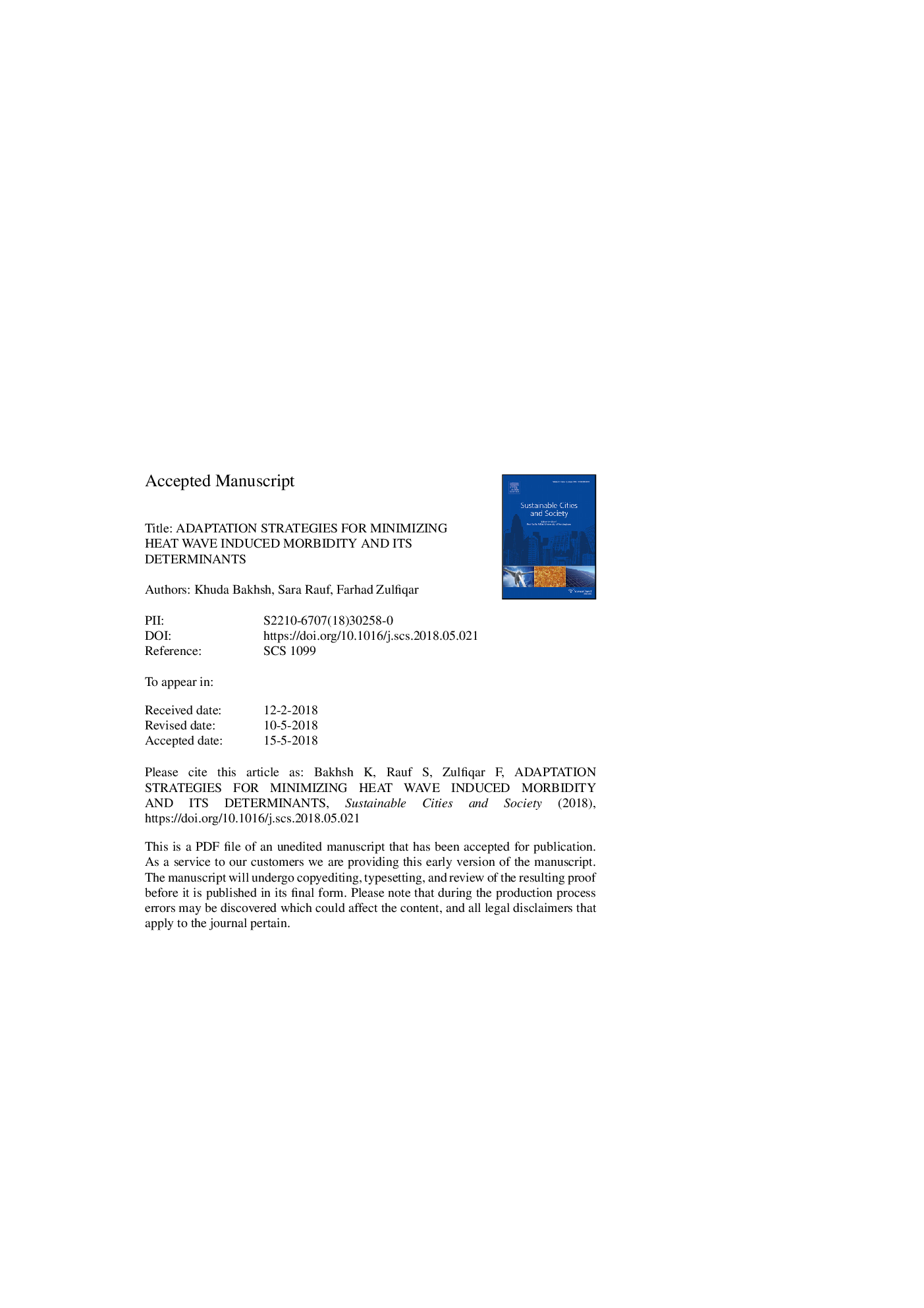| کد مقاله | کد نشریه | سال انتشار | مقاله انگلیسی | نسخه تمام متن |
|---|---|---|---|---|
| 6774877 | 1432007 | 2018 | 38 صفحه PDF | دانلود رایگان |
عنوان انگلیسی مقاله ISI
Adaptation strategies for minimizing heat wave induced morbidity and its determinants
ترجمه فارسی عنوان
استراتژی های سازگاری برای به حداقل رساندن بیماری های ناشی از گرما و عوامل تعیین کننده آن
دانلود مقاله + سفارش ترجمه
دانلود مقاله ISI انگلیسی
رایگان برای ایرانیان
کلمات کلیدی
امواج گرما، سازگاری حرارتی، تاثیرات بهداشتی، مسمومیت، اثر جزیره گرمایی شهری،
ترجمه چکیده
امواج گرم در بسیاری از کشورها، از جمله پاکستان، تهدیدات جدی برای سلامتی و مرگ و میر انسان را تهدید می کند. عوامل متعددی وجود دارد که موجب بروز بیماری های ناشی از گرما می شوند و برای جلوگیری از اثرات نامطلوب بر سلامت انسان، تعدادی از اقدامات سازگاری در دسترس هستند. این تحقیق به منظور بررسی اقدامات سازگاری مختلف انجام شده توسط پاسخ دهندگان و برآورد عوامل موثر بر بیماری های ناشی از گرما انجام شده است. طرح نمونه گیری شامل جمع آوری داده های اولیه از 251 پاسخ دهندگان در مناطق شهری و پری شهری فیصل آباد بود که یکی از شهرهای بزرگ پاکستان بود که با استفاده از یک پرسشنامه از پیش آزمون شده بود. رایج ترین استراتژی های سازگاری شناسایی شد و شاخص های استراتژی های سازگاری ایجاد شد. عوامل تعیین کننده تعداد بیماران در خانواده ای که رنج می برند از امواج گرما با استفاده از مدل رگرسیون پواسون برآورد شده است. یافته های تحقیق تقریبا مشابه نمرات سازگاری هر دو پاسخگوی شهروندان و شهرداری ها نشان می دهد که هیچ تفاوت در سطح سازگاری هر دو گروه وجود ندارد. راهکارهای انطباق پذیرفته شده اغلب در طول امواج گرما شامل استفاده از مقدار زیادی آب و آب، افزایش تعداد حمام ها، استفاده از چتر، پارچه / کلاه، عینک آفتابی و استفاده از صفحات سبز / جوجه در خانه است. مهمترین و مهمترین عوامل موثر بر میزان مرگ و میر ناشی از موج گرما، سازگاری با امواج گرمایی (ضبط شده با نمره سازگاری)، پس زمینه های شهری / شهری، اندازه خانواده، تعداد مردان و درآمد بالا بود. به این ترتیب، به این نتیجه رسیدیم که شیوه های انطباق در مواجهه با چالش های بهداشتی ناشی از امواج گرما، پیامدهای سلامتی قوی دارد. بر اساس یافته های تحقیق، پیشنهاد شده است که سیاست های بهداشتی با هدف کاهش اثرات بهداشتی امواج گرما بر روی کمپین های آگاهی رسانی در مورد راهکارهای سازگاری در دسترس با استفاده از منابع رسانه ای مختلف، گسترش دسترسی به امکانات بهداشتی و گسترش امکانات شنا مخصوصا در مناطق شهری تمرکز دارد. . این استراتژی ها مداخلات سیاستی مهم برای کاهش آسیب پذیری جمعیت به امواج گرما هستند.
موضوعات مرتبط
مهندسی و علوم پایه
مهندسی انرژی
انرژی های تجدید پذیر، توسعه پایدار و محیط زیست
چکیده انگلیسی
Heat waves pose serious health threats to human mortality and morbidity in many countries, including Pakistan. There are various factors that contribute towards heat wave induced morbidity and several adaptation measures are at disposal to avoid adverse effects on human health. This research was designed to examine different adaptation measures taken by the respondents and to estimate the determinants of heat wave induced morbidity. The sampling design consisted of primary data collection from 251 respondents in urban and peri-urban areas of Faisalabad, being one of the big cities in Pakistan, using a pre-tested questionnaire. The most common adaptation strategies were identified and an index of adaptation strategies was generated. The determinants of the number of patients in a family suffering from heat waves were estimated using Poisson regression model. The research findings revealed approximately the same adaptation scores of both urban and peri-urban respondents indicating no differences in adaptation level of both groups. The most commonly used adaptation strategies during heat waves included using plenty of water, and juices, increasing the number of baths, using an umbrella, cloth/cap, wearing sunglasses, and using green sheets/chicks in the house. The most important and statistically significant determinants of heat wave induced morbidity were the adaptation to heat waves (captured by adaptation score), urban/peri-urban background, family size, the number of males, and high income. Thus, it was concluded that the adaptation practices have strong health implications in the face of health challenges posed by heat waves. Based on the research findings, it is suggested that the health policies aimed at reducing the health impacts of heat waves may focus on awareness campaigns on available adaptation strategies through different media sources, widening access to health facilities, and extending swimming facilities particularly in urban areas. These strategies are important policy interventions to reduce vulnerability of population to heat waves.
ناشر
Database: Elsevier - ScienceDirect (ساینس دایرکت)
Journal: Sustainable Cities and Society - Volume 41, August 2018, Pages 95-103
Journal: Sustainable Cities and Society - Volume 41, August 2018, Pages 95-103
نویسندگان
Khuda Bakhsh, Sara Rauf, Farhad Zulfiqar,
